
Who does and doesn’t use patient portals
A look at the patients who do and do not take advantage of patient portals.
Despite the widespread availability of online patient portals, only 15 to 30 percent of patients use them, according to the U.S. Government Accountability Office.For a study published in Health Affairs, researchers sought to learn more about who is and isn’t using portals.They looked at the characteristics of 2,235 respondents in a national survey* according to whether the respondent had or had not used a portal during the previous year.*The 2017 Health Information National Trends Survey 5.
Newsletter
Stay informed and empowered with Medical Economics enewsletter, delivering expert insights, financial strategies, practice management tips and technology trends — tailored for today’s physicians.








